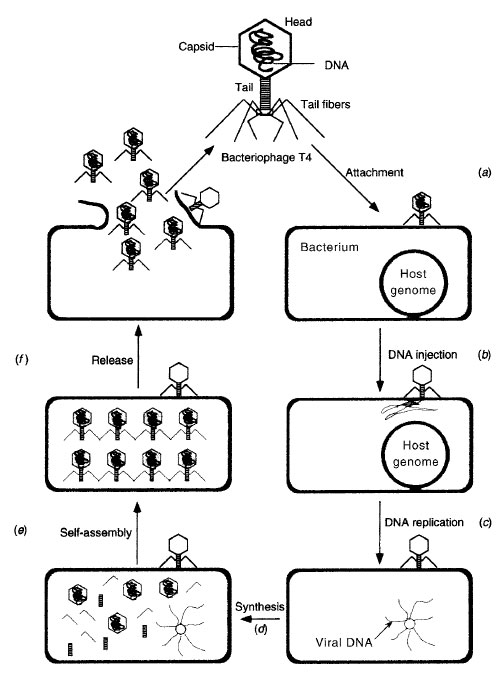Virulent Infection
Virulent Infection Assignment Help | Virulent Infection Homework Help
Virulent Infection
1. Adsorption or Attachment. The phage attaches itself to receptor sites on the wall of certain specific strains of E.coli bacteria by means of its tail fibres. In T-even phages the tail fibres are the special sites for absorption.
2. Digestion of the Bacterial Wall. After attachment, a small region of the cell wall of the bacterium is digested by the enzyme molecules attached to the tail of the phage. Lysozyme drills a hole in the mucopeptide layer of the cell wall. Attachment of a number of phages may cause lysis of the bacterial cell without infection, because of the many holes drilled.
3. Injection of DNA. Contraction of tail sheath pushes the core tube through the cell wall of the host cell, and DNA is injected into the cell. The core tube of T-even phages does not penetrate the bacterial plasma membrane. The tail sheath functions like a primitive muscle the core tube through the bacterial cell wall.
 ….
….4. Synthesis of Early Proteins. As soon as phage DNA enters the bacterial cell it takes control of cell’s metabolism for the synthesis of the phage. After infection most of the bacteria RNA synthesis stops and synthesis of phage mRNA begins. Only one of the viral DNA strands transcribes mRNA. Two sets of mRNA are produced in T-even phages, early mRNA and late mRNA. These correspond to the two sets of proteins, early and late proteins.
5. Breakdown of Bacterial DNA and RNA. It has been seen that the early proteins include DNase and RNase, which break down DNA and RNA, respectively.
6. Replication of Phage DNA. Nucleotides resulting from breakdown of bacterial DNA are utilized in the replication of phage DNA. The necessary enzymes for phage DNA replication have already been produced during synthesis of early proteins.
7. Synthesis of Late Proteins. The synthesis of late proteins takes place after replication of phage DNA. This synthesis is translated by late mRNA. The late proteins include coat proteins and phage lysozyme.
8. Maturation. The T4 baceriophage has 70-100 genes, of which about 50 are involved in morphogenesis. The process of assembly of the phage from its components is called maturation. The head, tail and tail fibers and completed independently, and then only do they combines.
9. Release. The release of progeny phages takes place by sudden explosion or bursting of the bacterial cell wall which has bee weakened by lysozomes. Molecules of lysozyme remain attached to the tip of the tail of the phage.
For more help in Virulent Infection please click the button below to submit your homework assignment.